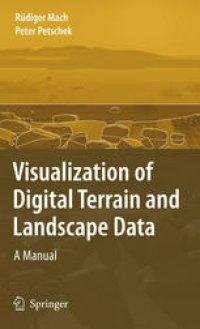
Ebook: Visualization of Digital Terrain and Landscape Data: A Manual
- Tags: Geographical Information Systems/Cartography, Landscape/Regional and Urban Planning, Landscape Architecture, Computer-Aided Engineering (CAD CAE) and Design, Computer Imaging Vision Pattern Recognition and Graphics
- Year: 2007
- Publisher: Springer-Verlag Berlin Heidelberg
- Edition: 1
- Language: English
- pdf
This book reflects a profound change that has taken place in the practice of landscape architecture and planning in the past twenty years. Traditional modes of representation – pen, pencil, watercolor, marker, et al – have been supplanted by digital modeling and animation. This transformation is not just in the medium of representation, however; it is more than a subs- tution of one marking device for another, such as may have been the case in the past when, for example, mechanical pens with cartridges replaced pens with nibs that were filled by dipping. Even changes such as that had their impacts (as longer straighter lines, for example, or more precision in details became possible) on the interplay between designer, design - dium, and designed artifact(s). The emergence of digital media as rep- sentational tools for designers has accompanied a transformation in the language of discourse in design and planning, in the very conception of the designed world we live in, and in the substance and role of the essential representations and abstractions used by planners and designers. In the past, when 2D planar representations (drawings, usually on paper) served as the conventional means of communication for designers (both with themselves and with others), physical objects or arrangements in 3D were transformed into a series of lines in 2D (plans, sections, elevations, e. g.
This book approaches the realisation of digital terrain and landscape data through clear and practical examples.
It covers a hugely relevant contemporary subject in a dynamic and comprehensive fashion and will be of special interest to anyone involved in 3-D graphic design, from landscape architects to game developers.
From data provision and the creation of revealing analyses to realistic depictions for presentation purposes, the reader is led through the world of digital 3-D graphics.
The authors’ deep knowledge of the scientific fundamentals and many years of experience in 3-D visualization enable them to lead the reader through a complex subject and shed light on previously murky virtual landscapes.
Material on aata evaluation and analysis, modelling, camera work and lighting, as well as the correct depiction of natural phenomena, atmospherical effects, and many tips for optimisation make the book a valuable guide to a fascinating subject.
This book approaches the realisation of digital terrain and landscape data through clear and practical examples.
It covers a hugely relevant contemporary subject in a dynamic and comprehensive fashion and will be of special interest to anyone involved in 3-D graphic design, from landscape architects to game developers.
From data provision and the creation of revealing analyses to realistic depictions for presentation purposes, the reader is led through the world of digital 3-D graphics.
The authors’ deep knowledge of the scientific fundamentals and many years of experience in 3-D visualization enable them to lead the reader through a complex subject and shed light on previously murky virtual landscapes.
Material on aata evaluation and analysis, modelling, camera work and lighting, as well as the correct depiction of natural phenomena, atmospherical effects, and many tips for optimisation make the book a valuable guide to a fascinating subject.
Content:
Front Matter....Pages i-xix
Introduction....Pages 1-11
Fundamentals and Data Source....Pages 13-40
3D Visualization of Terrain Data....Pages 41-88
Using the Camera....Pages 89-121
Lighting....Pages 123-150
Vegetation....Pages 151-187
Atmosphere....Pages 189-218
Water....Pages 219-254
Rendering & Post Processing....Pages 255-284
Interaction with 3D Data....Pages 285-309
Practical Examples....Pages 311-317
Back Matter....Pages 319-365
This book approaches the realisation of digital terrain and landscape data through clear and practical examples.
It covers a hugely relevant contemporary subject in a dynamic and comprehensive fashion and will be of special interest to anyone involved in 3-D graphic design, from landscape architects to game developers.
From data provision and the creation of revealing analyses to realistic depictions for presentation purposes, the reader is led through the world of digital 3-D graphics.
The authors’ deep knowledge of the scientific fundamentals and many years of experience in 3-D visualization enable them to lead the reader through a complex subject and shed light on previously murky virtual landscapes.
Material on aata evaluation and analysis, modelling, camera work and lighting, as well as the correct depiction of natural phenomena, atmospherical effects, and many tips for optimisation make the book a valuable guide to a fascinating subject.
Content:
Front Matter....Pages i-xix
Introduction....Pages 1-11
Fundamentals and Data Source....Pages 13-40
3D Visualization of Terrain Data....Pages 41-88
Using the Camera....Pages 89-121
Lighting....Pages 123-150
Vegetation....Pages 151-187
Atmosphere....Pages 189-218
Water....Pages 219-254
Rendering & Post Processing....Pages 255-284
Interaction with 3D Data....Pages 285-309
Practical Examples....Pages 311-317
Back Matter....Pages 319-365
....